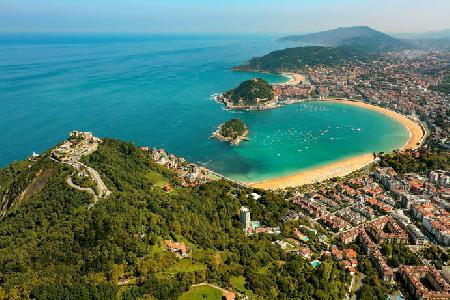 San Sebastián (or Donostia in Basque) is a coastal city and municipality, capital of the province of Guipúzcoa, located in the Basque Autonomous Community, in northern Spain. The city is located on the southern coast of the Bay of Biscay, 20 km from France. The municipality of San Sebastián has a population of 186,370 inhabitants (2016) and the entire region of San Sebastián has 436,500 inhabitants (2010).
San Sebastián (or Donostia in Basque) is a coastal city and municipality, capital of the province of Guipúzcoa, located in the Basque Autonomous Community, in northern Spain. The city is located on the southern coast of the Bay of Biscay, 20 km from France. The municipality of San Sebastián has a population of 186,370 inhabitants (2016) and the entire region of San Sebastián has 436,500 inhabitants (2010).
Dostonia's main economic activities are commerce and tourism, which is one of the most popular tourist destinations in Spain. Although San Sebastián is a small city, every year it hosts an important International Film Festival, one of the greatest arts events. San Sebastián, together with the Polish city of Wroclaw, was chosen as the European Capital of Culture for 2016.
The three picturesque beaches of San Sebastián - La Concha, Ondarreta and Zurriola - make it a popular tourist center. The city is surrounded by easily accessible mountains: the 123-meter-long Urgul (near the old part of the city), the small Ulija mountain range (which stretches east to Pasajes), Mount Adarra (in the southern part of the city) and Mount Igeldo (in the western part). Together they form a beautiful and characteristic terrain on the Donostia coast.
Because San Sebastián finally took the course of tourist development, Monte Urgul was no longer used by the military and in 1924 it was sold by them to the city council. Most of the mountain's surface is covered in trees, and the remaining military fortress at the top looks very picturesque, recalling the turbulent events of centuries past. The fortress houses a small history museum, which is part of the largest museum in San Telmo Museoa, located on the southeast slope. From the top of Monte Urgul you can enjoy beautiful views of the bay and the city.
Located at the mouth of the Urumea River, Donostia, in its current form, has been built in the last two centuries, mainly on swampy land. In fact, the city center and the Amara Berri and Riberas de Loiola neighborhoods are located at the old river bottom, which was launched through its current canal in the first half of the 20th century.
Town hall:
The San Sebastián City Hall is an elegant palace with towers in front of the Alderdi Eder Park. In 1882 it was built for a casino. When the gambling business closed, the building served as a hospital, party room, and resort. The mayor's office has occupied the palace since 1947.
Palace of the Deputation of Guipúzcoa:
It is located in the new part of San Sebastián, in the Plaza de la Guipúzcoa. It is a neoclassical building from 1885 with arched galleries, a sculptural group and the provincial emblem in the attic. At the top of the facade, in round niches, there are busts of political figures made by Ignacio Souloaga.
Victoria Eugenia Theater:
The Victoria Eugenia Theater was built on the model of the Paris Opera. It was designed by Francisca de Urkola. The cultural center was opened in 1912 and rebuilt in 2001-07. The eclectic building was designed in the Neoclassical, Neo-Renaissance, Neo-Lateral style; it is decorated with luxurious sculptural compositions. Until 1999, it was the site of the annual Film Festivals. Festivals are still held in the new Congress Palace.
Constitution Plaza:
The Plaza de la Constitución is a square space connected by arches to the neighboring streets. A place to gather tourists, celebrate city festivals and food festivals. The Plaza Nueva (old name) was built in 1723. After the fire of the war of 1813 and the great reconstruction, it was given the name of Plaza de la Constitución. Here you can see the old town hall, which now houses the library.
Cathedral of the good shepherd:
The Buen Pastor Cathedral is the largest religious structure in the province of Gipuzkoa. Its bell tower is visible from anywhere in San Sebastián. In the aspect of the neo-Gothic church of the Cathedral of the Good Shepherd there is a remarkable similarity with the Cathedral of Cologne. The construction of the temple began in 1881, and it was consecrated after 16 years. The marble floor and new stained glass windows appeared after reconstruction in 1972.
Maritime Museum:
The Naval Museum has been operating in the city's port since 1991. Since 2007, there is no permanent exhibition: only thematic exhibitions and training programs on the history of the sea of the Baskonia region are held.
San Sebastian Aquarium:
The Oceanography Museum is located in the Palacio del Mar on the pier. The San Sebastián Aquarium has been in operation since 1928. The building has a large 480 m² pool with an underwater tunnel that offers a panoramic panoramic view. In addition to the main oceanarium there are themed aquariums and ponds.
